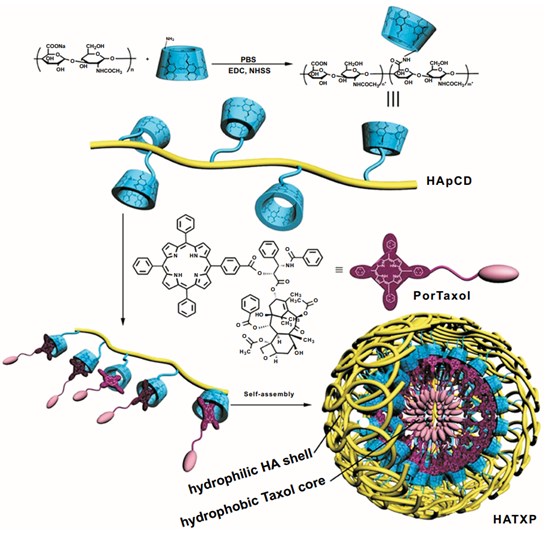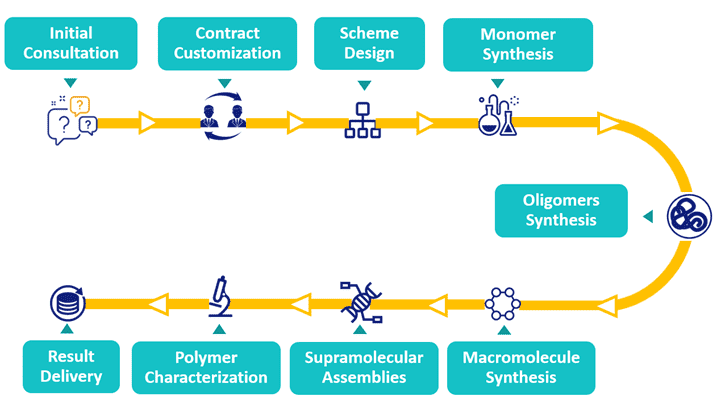Carbohydrate-polymer Conjugates
Carbohydrates have been used as precision templates to grow polymers with controlled polymerization techniques, generating carbohydrate-polymer conjugates with well-defined architectures. Armed with rich experience in polymer modification, BOC Sciences provides comprehensive carbohydrate-polymer conjugation strategies for our clients, and we are able to develop bioconjugation services for different carbohydrate molecules according to research targets.
Introduction of Carbohydrate-polymer Conjugates
Due to their unique features, such as biocompatibility, biodegradability, and multifunctionality, carbohydrates have attracted great interest in biomedical and materials fields. Furthermore, the conjugation of functional polymers to carbohydrates effectively improves the properties and broadens related applications. For example, cellulose, a polysaccharide and the most abundant biopolymer on earth, has been modified using modern polymerization techniques for various applications. Well-defined carbohydrate-polymer conjugates can be prepared by introducing monosaccharides or oligosaccharides to a precision polymer scaffold, improving bioconjugates' antiviral efficacy. Currently, controlled radical polymerization techniques have been principally studied for constructing glycopolymers, such as nitroxide mediated polymerization (NMP) and atom transfer radical polymerization (ATRP). Carbohydrates including cellulose, chitosan, pullulan, dextran, starch, and hyaluronan have also been modified using these polymerization methods and yielding functional materials for various applications, including drug and gene delivery.
 Fig. 1. A self-assembly construct of dextran-hyaluronic acid co-polymer for taxol delivery (Current Pharmaceutical Design. 2017, 23: 6019-6032).
Fig. 1. A self-assembly construct of dextran-hyaluronic acid co-polymer for taxol delivery (Current Pharmaceutical Design. 2017, 23: 6019-6032).
Carbohydrate polymers are among the most abundant biomolecules in nature and have exhibited a remarkable role in therapeutic manipulation of wide variant human diseases. They are natural polymeric molecules and are typically presented as structural or storage blocks based on function and monomer homogeneity in the composition. In particular, the application of structural and heteropolysaccharides has a long history in pharmaceutical sciences. They have been used as immune modulators, anti-tumor adjuvants, and anti-inflammatory agents in traditional medicine. Furthermore, different polysaccharides have gained extraordinary interest among researchers for different nanotechnology uses. Commercially, carbohydrate polymers have been applied to generate controlled release matrices, films, nanogels, hydrogels, microspheres, nanospheres, and coatings of the nanostructures to introduce attractive properties, including high stability, safety, low toxicity, hydrophilicity, biocompatibility, and biodegradability.
Applications of Carbohydrate-polymer Conjugates
- Drug Delivery and Imaging. Carbohydrate-polymer conjugates have been explored to deliver bioactive substances (drugs, dyes, proteins, genes, and nuclear materials). A wide range of polysaccharides such as chitosan, cyclodextrin, dextran, pullulan, alginate, and hyaluronic acid have been used as biodegradable carriers due to low toxicities.

- Tissue Engineering and Support. Carbohydrate-based materials are biocompatible that promote cell adhesion, proliferation, and differentiation. Polysaccharide-based nanomaterials with highly effective fundamental structures have been used for the controlled release of therapeutic agents, particularly as tumor-targeting vehicles and other biomedical applications.
- Bioadhesives. Tissue adhesives are used in wound closure and healing, drug delivery, implantation of medical devices, tissue engineering, and bone applications. The biodegradability and compatibility of polysaccharides enable them to be used as bioadhesives; for example, chitosan and oxidized polysaccharides have been widely utilized as bioadhesives.
Our Services for Carbohydrate-polymer Conjugates
Cellulose-polymer Functionalization
Modification by graft polymerization provides a means of altering cellulose's physical and chemical properties and increasing related functionality. With recent progress in polymer synthesis, new routes are provided to afford functional and sustainable cellulose based-materials. BOC Sciences can provide cellulose modification services via ionic and ring-opening graft polymerization and radical polymerization, including reversible addition-fragmentation chain transfer (RAFT) polymerization, atom transfer radical polymerization (ATRP), nitroxide-mediated polymerization (NMP), and ionic and ring-opening graft polymerization.
Polysaccharide-polymer Functionalization
Polysaccharide biopolymers are natural carbon-based products suitable for a wide range of extra modifications. The development of polysaccharide-based nanomaterials with a highly effective fundamental structure has been extensively studied to control the release of therapeutic agents, particularly tumor-targeting vehicles and other biomedical applications. BOC Sciences' polymerization technology platform offers bioconjugation strategies, such as living radical polymerization (LRP) and ring-opening polymerization (ROP), which provide numerous advantages in preparing well-defined polymer grafts with facile reaction conditions, unrestrained solvents, a broad range of functional monomers, and flexible structures.
Star-like Block Copolymer Synthesis
BOC Sciences can synthesize novel amphiphilic multiarm, star-like coil-rod diblock co-polymers via click chemistry using living polymerization. The star-like polymers can be used as unimolecular micelles for inorganic nanoparticle synthesis and drug and gene delivery. In particular, the preparation of monodisperse colloidal nanocrystals has demonstrated precisely controlled dimensions, compositions, and architectures when using the well-defined star-like polymers as nanoreactors. Because cellulose forms a rigid backbone, the strategy has been further extended to realize one-dimensional rod-like nanocrystals using cellulose-polymer conjugates as cylindrical unimolecular nanoreactors.
Our Polymer Bioconjugation Workflow

References
- Weil, T. et al. Polymer bioconjugates: Modern design concepts toward precision hybrid materials. Progress in Polymer Science. 2020, 105: 101241.
- Lutz, J.F. et al. Modern trends in polymer bioconjugates design. Prog. Polym. Sci. 2008, 33: 1-39.

 Fig. 1. A self-assembly construct of dextran-hyaluronic acid co-polymer for taxol delivery (Current Pharmaceutical Design. 2017, 23: 6019-6032).
Fig. 1. A self-assembly construct of dextran-hyaluronic acid co-polymer for taxol delivery (Current Pharmaceutical Design. 2017, 23: 6019-6032).













